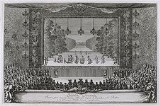
L'Opéra of the Palace of Versailles
Encyclopedia
The Opéra Royal de Versailles (Royal Opera of Versailles) is the main theatre and opera house of the Palace of Versailles
. Designed by Ange-Jacques Gabriel
, with interior decoration by Augustin Pajou
, the Opéra was constructed entirely of wood and painted to resemble marble in a technique known as faux marble.
The house is located at the northern extremity of the aile des nobles. General public access to the theater is gained though the two-story vestibule. Some parts of the Opéra, such as the loge du roi and boudoir du roi represent some of the earliest expressions of what would become known as the style Louis XVI .
Lully
’s Persée — written in 1682, the year Louis XIV moved into the palace — inaugurated the Opéra on 16 May 1770 in celebration of the marriage of the dauphin — the future Louis XVI — to Marie-Antoinette .
The Opéra Royal can serve either as a theater for opera, stage plays, or orchestral events, when it can accommodate an audience of 712, or as a salle des festins, when the floor of the orchestra level of the auditorium can be raised to the level of the stage. On these occasions, the Opéra can accommodate 1,200.
Princesse d’Élide débuted on 8 May. During this fête an additional theatre was erected inside the chateau for the presentation of three other plays by Molière
: Les Fâcheux, Le Mariage Forcé, and Tartuffe, which premiered in an incomplete, albeit contentious, form. None of these theatres survived this fête .
The Grand Divertissement royal of 1668, which celebrated the end of the War of Devolution
, witnessed the construction of a luxurious temporary theater built in the gardens on the site of the future Bassin de Bacchus. Constructed of papier-mâché, which was either gilded or painted to resemble marble and lapis lazuli, the theater seated 1,200 spectators who attended the debut of Molière’s
George Dandin on 18 July, 1668. As with the Plaisirs de l’Île enchantée
, this theater was destroyed shortly after the end of the fête .
The third fête or, more accurately, a series of six fêtes - Les Divertissments de Versailles - were held in July and August 1674 to celebrate the second conquest of Franche-Comté. The fête featured a number of theatrical productions that were staged throughout the grounds in temporary theaters. On 4 July, Lully’s
Alceste was performed for the court in the Cour de Marbre; on 11 July, Quinault’s
L'Églogue de Versailles was staged near the Trianon de Porcelaine
; eight days later, the Grotte de Thétys served as the setting for Molière’s
le Malade Imaginaire; and Racine’s
Iphigénie debuted on 18 August in a theater constructed in the Orangerie .
. This structure was destroyed in 1703 to accommodate a new apartment for the king.
Because the salle de la Comédie was designed for stage plays, Versailles lacked a theatre in which more elaborate productions could be staged. For larger productions, the Grand Manège (the covered riding arena) in the Grand Écurie was converted for more elaborate entertainments, but the space had limitations. In 1685, Louis XIV approved plans for the construction of a larger permanent theater that could the more elaborate productions, such as pièces à machines.
The pièces à machines were theatrical presentations using ballet, opera, and special staging effects that required a theatre that could accommodate the complicated machinery used in the production of these plays. The Salle des Machines at the Tuileries Palace
in Paris, designed by Carlo Vigarani
, was the closest to Versailles. However, with Louis XIV’s dislike for Paris – due in large part to his flight from the Tuileries
in 1651 – and his increasing wish to keep his court at Versailles, the king approved the construction of a larger theater in 1685. With a plan more grandiose than the theatre of the Tuileries
, the construction of this new theatre was much lauded by contemporary descriptions of Versailles .
Construction was planned for the northern end of the Aile des Nobles, and was well underway when the War of the League of Augsburg, which began in 1688, permanently halted construction. It would not be until the reign of Louis XV that construction on this site would resume .
However, owing to Louis XV proclivity for more a more intimate theater, a number of temporary theaters known as the théâtres des cabinets were created. These theaters were most often constructed in one of the rooms of the petit appartement du roi
, with the petite galerie being the most frequently used starting from 1746. In 1748, the Escalier des ambassadeurs was converted into a theatre, in which the Marquise de Pompadour
staged and acted in a number of plays. Two years later, the theatre was dismantled when the Escalier des ambassadeurs was destroyed for the construction of the appartement de Madame Adélaïde (Verlet, pp. 366-369).
Acutely aware of the need for a larger and more permanent theater, as early as the 1740s Louis XV, seriously considered reviving Louis XIV’s plans for a permanent salle de spectacle to be constructed at the northern end of the Aile de Nobles. However, owing to the Seven Years’ War, construction would not be able to commence for nearly 20 years. When fire destroyed the Grand Écurie and the theatre of the Manège in 1751, and since the salle de la Comédie had become an unfeasible venue due to its size for theatrical productions, Louis XV finally authorized Ange-Jacques Gabriel
to design the Opéra in 1763 .
design for the Opéra was exceptional for its time since it featured an oval plan. As an economy measure, the floor of the orchestra level can be raised to the level the stage, thus doubling the floor space. The transition from the auditorium to the stage is managed by the introduction of a giant order of engaged Corinthian columns, with a cornice ranging with the whole Ionic entablature. The proscenium is formed by two pairs of columns, coupled in depth, with their entablature. On either side two more pairs, more widely spaced, enclosed with three tiers of boxes . Breaking with traditional Italian-style theatres which stacked tiered boxes like chicken coops, two balconies ring the house, topped by an ample colonnade that seems to extend into infinity thanks to a play of mirrors . It was planned that the Opéra should serve not only as a theatre, but as ballroom or banqueting hall as well Verlet, p. 378. The theatre burned ten thousand candles in a single setting, therefore making it very expensive to rent the space out.
It opened May 16, 1770, with Lully's Persée .
On 1 October 1789, the gardes du corps du roi held a banquet to welcome the Flanders Regiment, which had just arrived to strengthen protection for the royal family against the revolutionary rumblings that were being heard in Paris. At this banquet, Louis XVI, Marie-Antoinette, and the dauphin
received the pledge of loyalty from these guards. Revolutionary journalist Jean-Paul Marat
described the banquet as a counter-revolutionary orgy, with the soldiers ripping off the blue-white-red cockades they had been wearing and replacing them with white ones, the color that symbolized the Bourbon
monarchy. In truth, there is no evidence of this act, and actual eyewitnesses and attendees, such as the queen's lady of the bedchamber Madame Campan, record no such destruction of cockades. This was the last event held in the Opéra during the Ancien Régime .
Built entirely of wood, which is painted in faux marble to represent stone, the Opéra has excellent acoustics and represents one of the finest examples of neo-classical decoration. The theme of the decoration is related to Apollo
and the Olympian deities. The decoration of the Opéra was directed by Augustin Pajou
, who executed the bas-reliefs panels that decorate the front of the loges. The ceiling features a canvas by Louis Jean-Jacques Durameau
in which Apollo
and the Muses are depicted .
In spite of the excellent acoustics and the opulent setting, the Opéra was not often used during the reign of Louis XVI, largely on grounds of cost. However, for those occasions when the Opéra was used, they became events of the day. Some of the more memorable uses of the Opéra during the reign of Louis XVI included:
(redecoration of the parts of the queen’s apartment for the empress Marie-Louise
) and Louis XVIII
, the Opéra did not reopen again until 1837, when Louis-Philippe redecorated the theater and presented Molière
’s Le Misanthrope
. During the state visit of Queen Victoria and Prince Albert
the Opéra Royal was converted into a banquet room for a gala dinner on 25 August 1855 . This was to be one of the most elaborate events staged at Versailles during the Second Empire
.
In 1872, during the Commune de Paris, the Opéra was converted by Edmond de Joly for use by the Assemblée nationale, who used the Opéra until 1876; between 1876 and 1879, the Sénat convened here.
. Since its restoration, the Opéra has been used for state functions as well as a variety of operatic and musical events (Langlois, 1958).
Today, with its superb acoustics and magnificent décor, the Opéra represents one of the finest 18th century opera houses in Europe. The importance of the Opéra Royal is directly linked to the history of the many theatres at Versailles and the history of theatrical stagings in 17th and 18th century France.
Palace of Versailles
The Palace of Versailles , or simply Versailles, is a royal château in Versailles in the Île-de-France region of France. In French it is the Château de Versailles....
. Designed by Ange-Jacques Gabriel
Ange-Jacques Gabriel
Ange-Jacques Gabriel was the most prominent French architect of his generation.Born to a Parisian family of architects and initially trained by the royal architect Robert de Cotte and his father , whom he assisted in the creation of the Place Royale at Bordeaux , the younger Gabriel...
, with interior decoration by Augustin Pajou
Augustin Pajou
Augustin Pajou was a French sculptor, born in Paris. At eighteen he won the Prix de Rome, and at thirty exhibited his Pluton tenant Cerbère enchaîné .-Selected works:...
, the Opéra was constructed entirely of wood and painted to resemble marble in a technique known as faux marble.
The house is located at the northern extremity of the aile des nobles. General public access to the theater is gained though the two-story vestibule. Some parts of the Opéra, such as the loge du roi and boudoir du roi represent some of the earliest expressions of what would become known as the style Louis XVI .
Lully
Jean-Baptiste Lully
Jean-Baptiste de Lully was an Italian-born French composer who spent most of his life working in the court of Louis XIV of France. He is considered the chief master of the French Baroque style. Lully disavowed any Italian influence in French music of the period. He became a French subject in...
’s Persée — written in 1682, the year Louis XIV moved into the palace — inaugurated the Opéra on 16 May 1770 in celebration of the marriage of the dauphin — the future Louis XVI — to Marie-Antoinette .
The Opéra Royal can serve either as a theater for opera, stage plays, or orchestral events, when it can accommodate an audience of 712, or as a salle des festins, when the floor of the orchestra level of the auditorium can be raised to the level of the stage. On these occasions, the Opéra can accommodate 1,200.
The French Enlightenment
During the French Enlightenment, the theatre became a place where political and social ideas were considered myths and superstitions were tested. As more Enlightenment thinkers began to question the tenets of religion, many eighteenth-century citizens began to replace the pulpit with the stage, and looked to the theatre for their moral instruction as well as entertainment. The nobility had a lot to do with the uprising of theatre during this time. Louis XIV, who is known as the "Sun King" for playing the allegorical character of the sun in "The Ballet of the Night" in 1653 , moved his royal court from the capital, Paris, to Versailles, aspiring to get more control of the government. The Opera, which was built for Louis XV, however, was not built until later. His mistress, Marie de Pompadour, patronized artists, actors, and musicians while bankrupting France. Meanwhile, the aristocracy and church paid no taxes, and the bourgeoisie picked up the tab for the monarchy's tastes and fun . Yet, it was not until after the death of Louis' mistress that the construction of the Opera began .Temporary theatres 1664 to 1674
During the early years of his reign of Louis XIV, theatres were often temporary structures, built for a particular event and destroyed after their use. The first such theater was constructed for the fête of the Plaisirs de l’Île enchantée, which was held in 1664. In the area west of what is now the Bassin d’Apollon, a temporary theater was constructed in which Molière’sMolière
Jean-Baptiste Poquelin, known by his stage name Molière, was a French playwright and actor who is considered to be one of the greatest masters of comedy in Western literature...
Princesse d’Élide débuted on 8 May. During this fête an additional theatre was erected inside the chateau for the presentation of three other plays by Molière
Molière
Jean-Baptiste Poquelin, known by his stage name Molière, was a French playwright and actor who is considered to be one of the greatest masters of comedy in Western literature...
: Les Fâcheux, Le Mariage Forcé, and Tartuffe, which premiered in an incomplete, albeit contentious, form. None of these theatres survived this fête .
The Grand Divertissement royal of 1668, which celebrated the end of the War of Devolution
War of Devolution
The War of Devolution saw Louis XIV's French armies overrun the Habsburg-controlled Spanish Netherlands and the Franche-Comté, but forced to give most of it back by a Triple Alliance of England, Sweden, and the Dutch Republic in the Treaty of Aix-la-Chapelle.-Background:Louis's claims to the...
, witnessed the construction of a luxurious temporary theater built in the gardens on the site of the future Bassin de Bacchus. Constructed of papier-mâché, which was either gilded or painted to resemble marble and lapis lazuli, the theater seated 1,200 spectators who attended the debut of Molière’s
Molière
Jean-Baptiste Poquelin, known by his stage name Molière, was a French playwright and actor who is considered to be one of the greatest masters of comedy in Western literature...
George Dandin on 18 July, 1668. As with the Plaisirs de l’Île enchantée
Plaisirs de l’Île enchantée
Plaisirs de l’Île enchantée in English means Pleasures of the Enchanted Island. The Enchanted Island references Louis XIV and his court. This was a party given to start the building campaigns for the Chateau de Versailles in particular to acquaint those involved in its construction, his wife,...
, this theater was destroyed shortly after the end of the fête .
The third fête or, more accurately, a series of six fêtes - Les Divertissments de Versailles - were held in July and August 1674 to celebrate the second conquest of Franche-Comté. The fête featured a number of theatrical productions that were staged throughout the grounds in temporary theaters. On 4 July, Lully’s
Jean-Baptiste Lully
Jean-Baptiste de Lully was an Italian-born French composer who spent most of his life working in the court of Louis XIV of France. He is considered the chief master of the French Baroque style. Lully disavowed any Italian influence in French music of the period. He became a French subject in...
Alceste was performed for the court in the Cour de Marbre; on 11 July, Quinault’s
Philippe Quinault
Philippe Quinault , French dramatist and librettist, was born in Paris.- Biography :Quinault was educated by the liberality of François Tristan l'Hermite, the author of Marianne. Quinault's first play was produced at the Hôtel de Bourgogne in 1653, when he was only eighteen...
L'Églogue de Versailles was staged near the Trianon de Porcelaine
Subsidiary structures of the Palace of Versailles
Five subsidiary structures located near the Palace of Versailles have a historical relation with the history and evolution of the palace. Of these five structure – the Ménagerie, the Pavillon de la Lanterne the Trianon de Porcelaine, the Grand Trianon , and the Petit Trianon – two have been...
; eight days later, the Grotte de Thétys served as the setting for Molière’s
Molière
Jean-Baptiste Poquelin, known by his stage name Molière, was a French playwright and actor who is considered to be one of the greatest masters of comedy in Western literature...
le Malade Imaginaire; and Racine’s
Jean Racine
Jean Racine , baptismal name Jean-Baptiste Racine , was a French dramatist, one of the "Big Three" of 17th-century France , and one of the most important literary figures in the Western tradition...
Iphigénie debuted on 18 August in a theater constructed in the Orangerie .
La salle de la Comédie, 1681 to 1769
In spite of the need for a permanent theater at Versailles, it would not be until 1681 that a permanent structure would be built. In that year, the Comptes des Bâtiments du Roi record payments for a theater that was constructed on the ground floor of the chateau between the corps de logis and the Aile de Midi. The interior of the theater – known as the salle de la Comédie – contained a semicircle of row seating with loges set into the bays of the lateral walls. On the south wall of the theater, abutting the wall of the Escalier des Princes, was the royal tribune, which contained a central room octagonal loge and two smaller loges on either side . The salle de la Comédie would function as a de facto permanent theater at Versailles until 1769, when it was destroyed in order to provide direct access to the gardens from the Cour Royale .Small theatre, 1688 to 1703
In 1688, Louis XIV ordered a small theater to be constructed in the north wing of the Grand TrianonGrand Trianon
The Grand Trianon was built in the northwestern part of the Domain of Versailles at the request of Louis XIV, as a retreat for the King and his maîtresse en titre of the time, the marquise de Montespan, and as a place where the King and invited guests could take light meals away from the strict...
. This structure was destroyed in 1703 to accommodate a new apartment for the king.
Because the salle de la Comédie was designed for stage plays, Versailles lacked a theatre in which more elaborate productions could be staged. For larger productions, the Grand Manège (the covered riding arena) in the Grand Écurie was converted for more elaborate entertainments, but the space had limitations. In 1685, Louis XIV approved plans for the construction of a larger permanent theater that could the more elaborate productions, such as pièces à machines.
The pièces à machines were theatrical presentations using ballet, opera, and special staging effects that required a theatre that could accommodate the complicated machinery used in the production of these plays. The Salle des Machines at the Tuileries Palace
Tuileries Palace
The Tuileries Palace was a royal palace in Paris which stood on the right bank of the River Seine until 1871, when it was destroyed in the upheaval during the suppression of the Paris Commune...
in Paris, designed by Carlo Vigarani
Carlo Vigarani
Carlo Vigarani was an Italian scenic designer who worked as "ingénieur du roi" and then "intendant des plaisirs du roi" at the court of the French king Louis XIV until 1690. He is best known for his design of the Salle des Machines at the Tuileries Palace in Paris....
, was the closest to Versailles. However, with Louis XIV’s dislike for Paris – due in large part to his flight from the Tuileries
Tuileries Palace
The Tuileries Palace was a royal palace in Paris which stood on the right bank of the River Seine until 1871, when it was destroyed in the upheaval during the suppression of the Paris Commune...
in 1651 – and his increasing wish to keep his court at Versailles, the king approved the construction of a larger theater in 1685. With a plan more grandiose than the theatre of the Tuileries
Tuileries Palace
The Tuileries Palace was a royal palace in Paris which stood on the right bank of the River Seine until 1871, when it was destroyed in the upheaval during the suppression of the Paris Commune...
, the construction of this new theatre was much lauded by contemporary descriptions of Versailles .
Construction was planned for the northern end of the Aile des Nobles, and was well underway when the War of the League of Augsburg, which began in 1688, permanently halted construction. It would not be until the reign of Louis XV that construction on this site would resume .
Return to temporary theatres and conversions, 1729 to 1770
With the return of the court to Versailles in 1722, spaces used by Louis XIV were once again pressed into service for the needs of the court. In 1729, as part of the festivities in celebration of the birth of the dauphin, a temporary theatre was constructed in the Cour de Marbre. The salle de la Comédie and the Manège of the Grand Écurie continued to be used as they had during the reign of Louis XIV.However, owing to Louis XV proclivity for more a more intimate theater, a number of temporary theaters known as the théâtres des cabinets were created. These theaters were most often constructed in one of the rooms of the petit appartement du roi
Petit appartement du roi
The petit appartement du roi of the Palace of Versailles is a suite of rooms used by Louis XIV, Louis XV, and Louis XVI. Located on the first floor of the palace, the rooms are found in the oldest part of the palace dating from the reign of Louis XIII. Under Louis XIV, these rooms housed the...
, with the petite galerie being the most frequently used starting from 1746. In 1748, the Escalier des ambassadeurs was converted into a theatre, in which the Marquise de Pompadour
Madame de Pompadour
Jeanne Antoinette Poisson, Marquise de Pompadour, also known as Madame de Pompadour was a member of the French court, and was the official chief mistress of Louis XV from 1745 to her death.-Biography:...
staged and acted in a number of plays. Two years later, the theatre was dismantled when the Escalier des ambassadeurs was destroyed for the construction of the appartement de Madame Adélaïde (Verlet, pp. 366-369).
Acutely aware of the need for a larger and more permanent theater, as early as the 1740s Louis XV, seriously considered reviving Louis XIV’s plans for a permanent salle de spectacle to be constructed at the northern end of the Aile de Nobles. However, owing to the Seven Years’ War, construction would not be able to commence for nearly 20 years. When fire destroyed the Grand Écurie and the theatre of the Manège in 1751, and since the salle de la Comédie had become an unfeasible venue due to its size for theatrical productions, Louis XV finally authorized Ange-Jacques Gabriel
Ange-Jacques Gabriel
Ange-Jacques Gabriel was the most prominent French architect of his generation.Born to a Parisian family of architects and initially trained by the royal architect Robert de Cotte and his father , whom he assisted in the creation of the Place Royale at Bordeaux , the younger Gabriel...
to design the Opéra in 1763 .
Construction of the Opéra, 1765 to 1770
Construction work on the Opéra began in earnest in 1765 and was completed in 1770. Gabriel reverted to an old design by J.H. Mansart and Gaspare Vigarani: the Salle des Ballets, at the far north end of the château, which had been abandoned at the outbreak of the War of the Spanish Succession. The terminal pavilion of the north wing, intended for this, had been carried up to its full height only on the garden side; on the street side it had advanced no further than the foundations . At the time, it represented the finest example in theatre design, having 712 seats, and it was the largest theatre in Europe. Today, it remains one of the few 18th century theaters to have survived to the present day. Gabriel’sAnge-Jacques Gabriel
Ange-Jacques Gabriel was the most prominent French architect of his generation.Born to a Parisian family of architects and initially trained by the royal architect Robert de Cotte and his father , whom he assisted in the creation of the Place Royale at Bordeaux , the younger Gabriel...
design for the Opéra was exceptional for its time since it featured an oval plan. As an economy measure, the floor of the orchestra level can be raised to the level the stage, thus doubling the floor space. The transition from the auditorium to the stage is managed by the introduction of a giant order of engaged Corinthian columns, with a cornice ranging with the whole Ionic entablature. The proscenium is formed by two pairs of columns, coupled in depth, with their entablature. On either side two more pairs, more widely spaced, enclosed with three tiers of boxes . Breaking with traditional Italian-style theatres which stacked tiered boxes like chicken coops, two balconies ring the house, topped by an ample colonnade that seems to extend into infinity thanks to a play of mirrors . It was planned that the Opéra should serve not only as a theatre, but as ballroom or banqueting hall as well Verlet, p. 378. The theatre burned ten thousand candles in a single setting, therefore making it very expensive to rent the space out.
It opened May 16, 1770, with Lully's Persée .
On 1 October 1789, the gardes du corps du roi held a banquet to welcome the Flanders Regiment, which had just arrived to strengthen protection for the royal family against the revolutionary rumblings that were being heard in Paris. At this banquet, Louis XVI, Marie-Antoinette, and the dauphin
Louis XVII of France
Louis XVII , from birth to 1789 known as Louis-Charles, Duke of Normandy; then from 1789 to 1791 as Louis-Charles, Dauphin of France; and from 1791 to 1793 as Louis-Charles, Prince Royal of France, was the son of King Louis XVI of France and Queen Marie Antoinette...
received the pledge of loyalty from these guards. Revolutionary journalist Jean-Paul Marat
Jean-Paul Marat
Jean-Paul Marat , born in the Principality of Neuchâtel, was a physician, political theorist, and scientist best known for his career in France as a radical journalist and politician during the French Revolution...
described the banquet as a counter-revolutionary orgy, with the soldiers ripping off the blue-white-red cockades they had been wearing and replacing them with white ones, the color that symbolized the Bourbon
House of Bourbon
The House of Bourbon is a European royal house, a branch of the Capetian dynasty . Bourbon kings first ruled Navarre and France in the 16th century. By the 18th century, members of the Bourbon dynasty also held thrones in Spain, Naples, Sicily, and Parma...
monarchy. In truth, there is no evidence of this act, and actual eyewitnesses and attendees, such as the queen's lady of the bedchamber Madame Campan, record no such destruction of cockades. This was the last event held in the Opéra during the Ancien Régime .
Built entirely of wood, which is painted in faux marble to represent stone, the Opéra has excellent acoustics and represents one of the finest examples of neo-classical decoration. The theme of the decoration is related to Apollo
Apollo
Apollo is one of the most important and complex of the Olympian deities in Greek and Roman mythology...
and the Olympian deities. The decoration of the Opéra was directed by Augustin Pajou
Augustin Pajou
Augustin Pajou was a French sculptor, born in Paris. At eighteen he won the Prix de Rome, and at thirty exhibited his Pluton tenant Cerbère enchaîné .-Selected works:...
, who executed the bas-reliefs panels that decorate the front of the loges. The ceiling features a canvas by Louis Jean-Jacques Durameau
Louis Jean-Jacques Durameau
Louis-Jacques Durameau was a French painter.-Life:A son of Jacques Durameau and Marie Rocou , he was intended for an engraver by his father and trained in drawing at the studio of the sculptor Jean-Baptiste Defernex. He then entered the studio of Jean-Baptiste Marie Pierre...
in which Apollo
Apollo
Apollo is one of the most important and complex of the Olympian deities in Greek and Roman mythology...
and the Muses are depicted .
In spite of the excellent acoustics and the opulent setting, the Opéra was not often used during the reign of Louis XVI, largely on grounds of cost. However, for those occasions when the Opéra was used, they became events of the day. Some of the more memorable uses of the Opéra during the reign of Louis XVI included:
- 5 May 1777: Revival of Jean-Philippe Rameau’sJean-Philippe RameauJean-Philippe Rameau was one of the most important French composers and music theorists of the Baroque era. He replaced Jean-Baptiste Lully as the dominant composer of French opera and is also considered the leading French composer for the harpsichord of his time, alongside François...
, Castor et Pollux for the visit of the Emperor Joseph IIJoseph II, Holy Roman EmperorJoseph II was Holy Roman Emperor from 1765 to 1790 and ruler of the Habsburg lands from 1780 to 1790. He was the eldest son of Empress Maria Theresa and her husband, Francis I...
, Marie-Antoinette’s brother. - 23 May 1782: Revival of la Reine de Golconde by Michel-Jean SedaineMichel-Jean SedaineMichel-Jean Sedaine was a French dramatist, was born in Paris.- Biography :His father, who was an architect, died when Sedaine was quite young, leaving no fortune, and the boy began life as a mason's labourer...
; - 29 May 1782: Revival of Christoph Willibald Glück’sChristoph Willibald GluckChristoph Willibald Ritter von Gluck was an opera composer of the early classical period. After many years at the Habsburg court at Vienna, Gluck brought about the practical reform of opera's dramaturgical practices that many intellectuals had been campaigning for over the years...
opera, Iphigénie en Aulide and the revival of Maximilien Gardel’sMaximilien GardelMaximilien Gardel was a French ballet dancer and choreographer of German descent .He débuted at the Académie royale de Musique in Paris in 1759 and...
ballet Ninette à la Cour; - 8 June 1782: Dress ball held in honor of the visit of the comte and comtess du Nord, the Grand Duke PaulPaul I of RussiaPaul I was the Emperor of Russia between 1796 and 1801. He also was the 72nd Prince and Grand Master of the Order of Malta .-Childhood:...
and Grand Duchess of Marie Feodorovna of Russia who were traveling incognito . - 14 June 1784: Revival of Glück’sChristoph Willibald GluckChristoph Willibald Ritter von Gluck was an opera composer of the early classical period. After many years at the Habsburg court at Vienna, Gluck brought about the practical reform of opera's dramaturgical practices that many intellectuals had been campaigning for over the years...
Armide for the visit of Gustav III of SwedenGustav III of SwedenGustav III was King of Sweden from 1771 until his death. He was the eldest son of King Adolph Frederick and Queen Louise Ulrica of Sweden, she a sister of Frederick the Great of Prussia....
.
The Opéra after the Revolution
When the royal family left Versailles in October 1789, the château and the Opéra were closed. While the château did see some activity under Napoléon INapoleon I
Napoleon Bonaparte was a French military and political leader during the latter stages of the French Revolution.As Napoleon I, he was Emperor of the French from 1804 to 1815...
(redecoration of the parts of the queen’s apartment for the empress Marie-Louise
Marie Louise, Duchess of Parma
Marie Louise of Austria was the second wife of Napoleon I, Emperor of the French and later Duchess of Parma...
) and Louis XVIII
Louis XVIII of France
Louis XVIII , known as "the Unavoidable", was King of France and of Navarre from 1814 to 1824, omitting the Hundred Days in 1815...
, the Opéra did not reopen again until 1837, when Louis-Philippe redecorated the theater and presented Molière
Molière
Jean-Baptiste Poquelin, known by his stage name Molière, was a French playwright and actor who is considered to be one of the greatest masters of comedy in Western literature...
’s Le Misanthrope
Le Misanthrope
The Misanthrope is a 17th-century comedy of manners in verse written by Molière. It was first performed on 4 June 1666 at the Théâtre du Palais-Royal, Paris by the King's Players....
. During the state visit of Queen Victoria and Prince Albert
Prince Albert
Prince Albert was the husband and consort of Queen Victoria.Prince Albert may also refer to:-Royalty:*Prince Albert Edward or Edward VII of the United Kingdom , son of Albert and Victoria...
the Opéra Royal was converted into a banquet room for a gala dinner on 25 August 1855 . This was to be one of the most elaborate events staged at Versailles during the Second Empire
Second French Empire
The Second French Empire or French Empire was the Imperial Bonapartist regime of Napoleon III from 1852 to 1870, between the Second Republic and the Third Republic, in France.-Rule of Napoleon III:...
.
In 1872, during the Commune de Paris, the Opéra was converted by Edmond de Joly for use by the Assemblée nationale, who used the Opéra until 1876; between 1876 and 1879, the Sénat convened here.
The Opéra Royal since 1950
1952-1957 witnessed major restoration of the Opéra – generally considered one of the finest restoration projects undertaken at Versailles – when it was restored under the direction of André Japy to its 1770 state (Verlet, p. 384). The Opéra officially reopened on 9 April 1957 in the presence of Queen Elizabeth II of the United Kingdom, with a presentation of Act II of Rameau’s Les Indes GalantesLes Indes galantes
Les Indes galantes is an opéra-ballet consisting of a prologue and four entrées by Jean-Philippe Rameau with libretto by Louis Fuzelier...
. Since its restoration, the Opéra has been used for state functions as well as a variety of operatic and musical events (Langlois, 1958).
Today, with its superb acoustics and magnificent décor, the Opéra represents one of the finest 18th century opera houses in Europe. The importance of the Opéra Royal is directly linked to the history of the many theatres at Versailles and the history of theatrical stagings in 17th and 18th century France.
Gallery of images
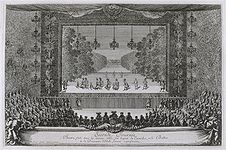 |
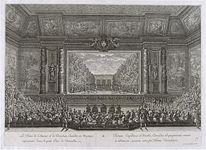 |
 |
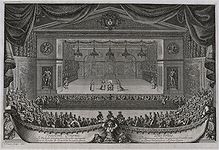 |
| Les Plaisirs de l'Ile Enchantée, termporary theater built for the production of Molière’s la Princess d’Élide (8 May 1664). Silvestre Israël Silvestre, 1621-1691. | Grand Divertissement royal, temporary theater built for the production of Molière’s Georges Dandin (15 July 1668) Jean Le Pautre Jean le Pautre Jean le Pautre was a French designer and engraver. Le Pautre was an apprentice to a carpenter and builder. In addition to learning mechanical and constructive work, he developed considerable skill with the pencil... , 1618-1682. |
Les Divertissments de Versailles, the Cour de Marbre serving as a theater for the production of Quinault’s Philippe Quinault Philippe Quinault , French dramatist and librettist, was born in Paris.- Biography :Quinault was educated by the liberality of François Tristan l'Hermite, the author of Marianne. Quinault's first play was produced at the Hôtel de Bourgogne in 1653, when he was only eighteen... and Lully’s Jean-Baptiste Lully Jean-Baptiste de Lully was an Italian-born French composer who spent most of his life working in the court of Louis XIV of France. He is considered the chief master of the French Baroque style. Lully disavowed any Italian influence in French music of the period. He became a French subject in... Alceste (4 July 1674). |
Les Divertissments de Versailles, temporary theater built before the Grotte de Thétys for the revival of Molière’s le Malade imaginaire. (18 July 1674). Jean Le Pautre Jean le Pautre Jean le Pautre was a French designer and engraver. Le Pautre was an apprentice to a carpenter and builder. In addition to learning mechanical and constructive work, he developed considerable skill with the pencil... , 1618-1682. |
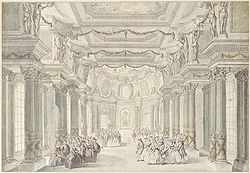 |
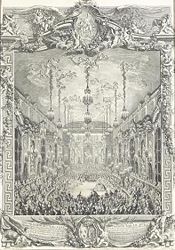 |
|
| “Presentation of the comédie-ballet " La Princesse de Navarre" given in the manège of the Grande Écurie of Versailles on the occasion of the marriage of the Dauphin to the Infanta Maria-Thérèse-Raphaëlle of Spain (23 February 1745).” Charles Nicolas Cochin (le Jeune), 1715-1790. | “" Acis et Galatée ", presented on the stage of the theater constructed in the escalier des Ambassadeurs at Versailles (23 January – 10 February 1749.” Adolphe Lalauze, 1838-1906 (ca. 1890 after a design by Cochin). | “Fancy dress ball given by the king in the manège of the Grande Écurie of Versailles on the occasion of the marriage of the Dauphin to the Infanta Maria-Thérèse-Raphaëlle of Spain (24 February 1745).” Charles Nicolas Cochin (le Jeune), 1715-1790. |
 |
 |
|
| “Inauguration of the Opéra, 16 May 1770.” Jean-Michel Moreau (1741-1814). |
Ceiling of the Opéra royal de Versailles. “Apollo preparing the crowns for illustrious Men of the Arts” ca. 1770. Louis Jean-Jacques Durameau Louis Jean-Jacques Durameau Louis-Jacques Durameau was a French painter.-Life:A son of Jacques Durameau and Marie Rocou , he was intended for an engraver by his father and trained in drawing at the studio of the sculptor Jean-Baptiste Defernex. He then entered the studio of Jean-Baptiste Marie Pierre... (1733-1796). |
Auditorium of the Opéra de Versailles during the celebrations of the wedding of the dauphin and Marie Antoinette in 1770. Jean-Michel Moreau (1741–1814). |
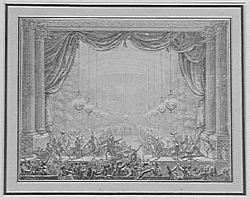 |
 |
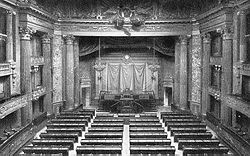 |
| “Banquet of the gardes du corps given in the Opéra de Versailles, 1 October 1789.” Jean-Louis Prieur (1759-1795). |
Banquet offered by Napoléon III to Queen Victoria and Prince Albert in the Opéra de Versailles, 25 August 1855. Eugène Lami Eugène Lami Eugène Louis Lami was a French painter and lithographer. He worked at the studio of Horace Vernet then studied at the École des Beaux-Arts in Paris with Camille Roqueplan and Paul Delaroche under Antoine-Jean Gros... (1800-1890) |
The Opéra de Versailles converted for the use of the Sénat of the Third Republic, ca. 1876. |

